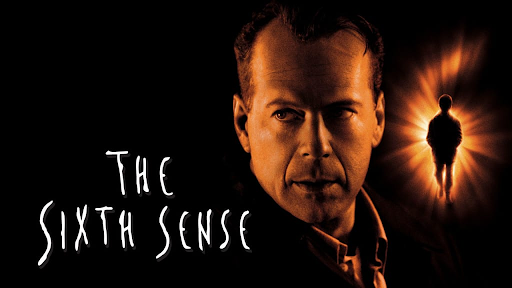The Sixth Sense: K. Night Shyamalan’s Hit Debut

January 4, 2022
Nowhere within the lines of ‘The Sixth Sense’ would you ever guess that the story goes beyond what is right in front of your eyes for the majority of the nearly two hours you spend watching. Although it’s rated PG-13 and labeled as a “horror/thriller,” I would by no means say I was horrified at any point but instead consumed within the twists and turns of the storyline. The film follows a troubled 8-year old boy named Cole Sear (played by Haley Joel Osment) as he grapples with a secret he has only told his doting child psychologist, Dr. Malcolm Crowe. As the story progresses, Dr. Crowe (played by Bruce Willis) tries to make sense of Cole’s concerning behavior, noting everything from kleptomania to possible schizophrenia.
Cole’s behavior reminds Dr. Crowe of a patient he treated years prior named Vincent Grey (played by Donnie Whalberg). Vincent’s story is brilliantly woven into the movie by director M. Night Shyamalan. As Vincent only appears to be featured within the first ten minutes of the movie, one might think that his presence is only used to show viewers what Dr. Crowe is relating Cole’s case back to towards the middle of the film. However, the small amount of screen time he is given shapes the movie from start to finish. If you happen to watch the film again, you might even wonder how Shyamalan manages to keep the viewer so enveloped in the story as to not notice the small traces he leaves of reality.
Surprisingly, this was M. Night Shymalan’s first large-budget film, made in conjunction with big names such as Hollywood Pictures (a Disney company) and Spyglass Entertainment. The budget for the 1999 film was capped at $60 million, which proved well worth it when the movie brought in $672.8 million at the box office. In the year of anticipation for the turn of the century, The Sixth Sense was an instant sensation, being the second-most successful of that year (behind Star Wars: Episode 1- The Phantom Menace).
Its success is not surprising, though- unlike highly anticipated movies, such as those in the Marvel franchise, The Sixth Sense showed all the characteristics of a truly good film. The advertising was good enough to bring in $26 million within the first five weekends, even though it was released on August 6; a universally uneventful day, and therefore an unorthodox one on which to release a movie. That’s $26 million worth of tickets people bought for a film they knew nothing about. After this, all that was left was for the movie to spread its own word. As people who had seen the movie told others about the fantastic plot twist, more and more viewers kept coming in, creating a consistent profit for the following weeks, all the way to Labor day weekend, when it made $29 million.
Even though the movie is older, it’s a great movie to rewatch for the plot. Shyamalan sneaks in details within the low-key lighting that a first-time viewer is bound to miss. Hue is also brilliantly changed from scene to scene, depicting the change between Dr. Crowe interacting with Cole- a more childlike experience, which uses a cool-toned hue, to him interacting with his wife- a darker subject, which explains the more golden-dim hue.
Yet, more interesting than the lighting choices used in the film is the intentionally placed and stark silence that highlights the fullness of the concepts put forward. In addition, the use of background noise and diegetic sound contributes to the viewer’s engagement, making them feel as if they are a part of each scene- possibly even jumping at things that not just anyone can make startling. In combination with the script, which is written mainly in dialogue, all of this creates a deeply personal and emotional experience.
Whether it be the fiercely caring relationship between Cole and his mother or the feeling of grief hanging in the air between Dr. Crowe and his wife, Anna, it seems no one who watches can get through without it hitting a nerve. The raw and intrinsic emotion captured in every scene illustrates the emotion one might feel regardless of upbringing or stage of life. Personally, I related to the atmosphere and rush of a single-parent household. On the other hand, my mom found the concept that loved ones could speak to you after their passing especially touching.
The idea of what happens after death is an innately human obsession. For millenniums, humans have wondered not only this but especially what happens when a soul has unfinished business when they pass. This grasping subject was used as a clever vessel for what I think was the main agenda of the film: Dr. Crowe was always known as a genius child psychologist. However, when a child came to him with unconventional claims, he was sent off with the conclusion that these were delusions to be fixed, rather than believed in. This ended up being the regret of Crowe’s lifetime. However, Cole represented a second chance for him. By believing Cole, Dr. Crowe was better able to help, and the story ends with Crowe knowing that by helping Cole cope with his reality, he set him up for a better future.

